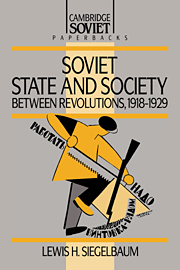Book contents
2 - The crisis of 1920–1921
Published online by Cambridge University Press: 06 January 2010
Summary
All is sold, all is lost, all is plundered,
Death's wing has flashed black on our sight,
All's gnawed bare with sore want and sick longing –
Then how are we graced with this light?
(Anna Akhmatova, Anno Domini MCMXII, quoted in Jurgen Ruhle, Literature and Revolution [London, 1969], p. 98)“The state swelled up; the people grew lean.” Such was the verdict of the great nineteenth-century Russian historian, Vasilii Kliuchevskii, on the frenzied years of Peter the Great's reign. Such might also serve as a depiction of Soviet Russia after six years of war, revolution, and civil war. By 1921, the Soviet state had swelled up in three respects. First, after being reduced in 1919 to an area roughly the same as sixteenth-century Muscovy, Soviet power was extended to the borders of the Baltic states and Poland in the west, the Arctic Ocean in the north, the Black Sea in the south and the Transbaikal region in the east. Second, having appropriated economic, social and cultural transactions formerly performed by non- or semi-governmental institutions and individuals, the state had expanded its administrative apparatus. Third, the number of state officials and employees correspondingly grew, overwhelming the party that was supposed to be guiding them.
- Type
- Chapter
- Information
- Soviet State and Society between Revolutions, 1918–1929 , pp. 67 - 84Publisher: Cambridge University PressPrint publication year: 1992

